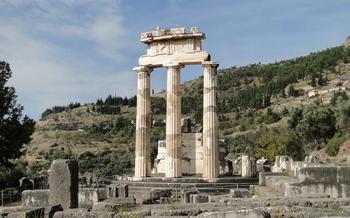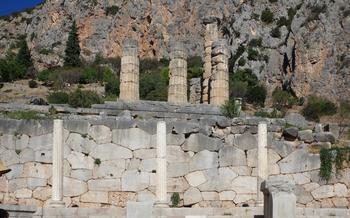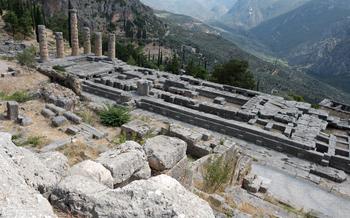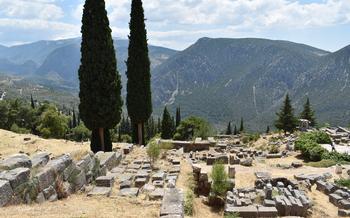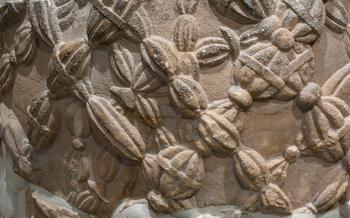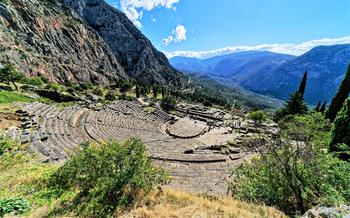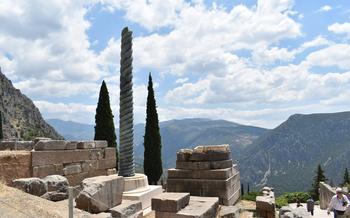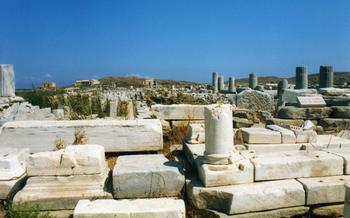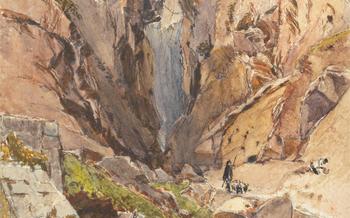
Corycian Cave
- Delphi: A Sacred Place
- Corycian Cave: A Hidden Gem
- Natural Beauty and Scenic Views
- Exploring the Cave
- The Oracle Chamber: A Place of Prophecy and Reverence
- The Treasury of Athens
- The Sanctuary of Apollo
- The Delphi Museum
- The Castalian Spring
- The Phaedriades Rocks
- Accommodation and Dining Options
- Getting to Delphi
- Best Time to Visit
- Delphi Archaeological Museum
- Insider Tip: Explore Beyond the Main Sites
Delphi: A Sacred Place
Delphi, nestled in the picturesque valley of Phocis, holds a revered position in the annals of ancient Greece. As a sanctuary and oracle, it served as a spiritual and cultural epicenter, attracting pilgrims, statesmen, and individuals seeking divine guidance from the Oracle of Delphi. The Pythia, a priestess believed to be the mouthpiece of the god Apollo, delivered enigmatic prophecies that shaped the course of history and influenced decisions across the Hellenic world. In recognition of its exceptional significance, Delphi was designated a UNESCO World Heritage Site, a testament to its enduring legacy as a sacred place that transcended time.
Over the centuries, archaeological excavations have unearthed a treasure trove of artifacts and ruins, shedding light on Delphi's rich past. The remains of temples, theaters, treasuries, and other structures stand as silent witnesses to the grandeur and devotion that once permeated this sacred site. Among the most notable discoveries is the Sanctuary of Apollo, with its awe-inspiring Temple of Apollo, where the Oracle delivered her cryptic pronouncements. These ruins, preserved with meticulous care, offer a glimpse into the rituals, beliefs, and practices that defined ancient Greek religion.
Corycian Cave: A Hidden Gem
Location and Geological Formation
Nestled amidst the majestic slopes of Mount Parnassus, approximately 20 kilometers from the ancient city of Delphi, lies the enigmatic Corycian Cave, a natural wonder that has captivated the imagination of explorers and historians alike. Formed over millions of years by the relentless forces of water erosion, this subterranean labyrinth extends for over 3 kilometers, boasting a series of interconnected chambers, tunnels, and impressive geological formations.
Myths and Legends
The Corycian Cave holds a prominent place in Greek mythology, serving as a sacred sanctuary dedicated to the god Pan, the protector of shepherds and flocks. According to ancient legends, Pan resided within the cave, playing his enchanting melodies on his pan flute and captivating all who ventured near. The cave's association with Pan has imbued it with an aura of mystery and enchantment, attracting visitors eager to connect with the realm of ancient Greek mythology.
Discovery and Exploration
The Corycian Cave remained largely unexplored until the late 19th century when archaeologists and spelunkers began to delve into its depths. Their efforts unveiled a treasure trove of archaeological artifacts, including pottery shards, tools, and even human remains, providing valuable insights into the cave's ancient inhabitants. In modern times, guided tours have made this subterranean marvel accessible to the public, allowing visitors to witness its stunning stalactites, stalagmites, and otherworldly rock formations, a testament to the power and artistry of nature.
Natural Beauty and Scenic Views
The Corycian Cave is not only a geological wonder but also a haven for nature enthusiasts. The surrounding landscape is breathtaking, with panoramic views of the valley and the towering mountains. The cave itself is home to a unique flora and fauna, including rare and endangered species. Visitors can explore the cave and marvel at the intricate stalactites and stalagmites that adorn its walls and ceiling. The natural beauty of the Corycian Cave provides ample opportunities for photography and nature appreciation, making it a must-visit destination for anyone seeking a unique and immersive experience in Greece.
Exploring the Cave
To fully appreciate the wonders of the Corycian Cave, guided tours are highly recommended. These tours, led by experienced guides, provide insightful commentary and ensure visitors' safety while navigating the cave's intricate passages. The duration of the tour typically ranges from 45 minutes to an hour, depending on the group size and the level of exploration desired.
The cave exploration is suitable for visitors of all ages and fitness levels, making it an accessible and enjoyable experience for everyone. However, it's essential to wear comfortable shoes and clothing, as the cave floor can be uneven and slippery. Additionally, visitors should bring a flashlight or headlamp to illuminate the cave's darker corners.
Safety is a top priority during cave exploration. Visitors should stay on designated paths and avoid touching or disturbing the delicate cave formations. Helmets are provided for added protection, and visitors are advised to follow the guide's instructions carefully.
The highlights of the cave exploration include the awe-inspiring stalactites and stalagmites, which create a surreal and enchanting atmosphere. The cave is home to a variety of these formations, ranging from delicate, needle-like structures to massive pillars that tower overhead. The play of light on the cave walls and the echoing sounds of dripping water add to the magical ambiance of the Corycian Cave, making it a truly unforgettable experience.
The Oracle Chamber: A Place of Prophecy and Reverence
Deep within the Corycian Cave lies the Oracle Chamber, a sacred space where the Pythia, the Oracle of Delphi, delivered her enigmatic prophecies. This awe-inspiring chamber, imbued with an air of mystery and reverence, was the heart of the ancient oracle's operations.
In this hallowed chamber, the Pythia, believed to be a conduit between the divine and the mortal realms, would enter a trance-like state, fueled by sacred vapors emanating from the earth. While in this trance, she would utter cryptic pronouncements, which were then interpreted by the priests of Apollo and relayed to those seeking guidance.
Archaeological excavations within the Oracle Chamber have uncovered fascinating artifacts and inscriptions that shed light on the rituals and practices associated with the oracle. These findings include votive offerings, such as statues, pottery, and jewelry, left by grateful petitioners who sought the oracle's wisdom and favor.
One of the most remarkable features of the Oracle Chamber is its acoustics. The chamber's unique shape and construction create an echo effect that amplifies and reverberates the Pythia's words, adding to the mystical atmosphere of the space. Some scholars believe that this acoustic phenomenon may have played a role in the oracle's pronouncements, enhancing their perceived authority and divinity.
Step into the Oracle Chamber and feel the weight of history envelop you. Imagine the hushed whispers of ancient seekers, the intoxicating fumes rising from the earth, and the Pythia's voice echoing through the chamber, delivering messages that shaped the destinies of nations. It is a place where the veil between the mortal and divine realms seems thin, where the whispers of the gods can still be heard.
The Treasury of Athens
The Treasury of Athens, also known as the Athenian Treasury, was a monumental structure built by the ancient Athenians to house their offerings to the god Apollo at his sanctuary in Delphi. Constructed in the 5th century BC, it was one of the most prominent and well-preserved treasuries at the site.
The Treasury was a rectangular building, approximately 6 meters wide and 9 meters long, constructed from limestone and marble. Its exterior was adorned with elaborate carvings and sculptures, depicting scenes from Greek mythology and the history of Athens. The most notable feature was the Ionic frieze, which showcased a continuous narrative of the battle between the gods and the giants.
Inside the Treasury, there were several chambers and niches used to store the Athenians' dedications. These offerings included precious metals, coins, jewelry, and various artifacts. The Treasury served as a testament to the wealth and power of Athens, as well as their deep devotion to Apollo.
Over the centuries, the Treasury of Athens underwent various modifications and restorations. During the Roman period, it was converted into a temple dedicated to the emperor Hadrian. Later, it was incorporated into a Christian church, and its sculptures were removed and dispersed.
Today, the Treasury of Athens stands as a magnificent ruin, its architectural features and decorative elements still visible despite the passage of time. It remains an important monument that offers valuable insights into the religious, political, and artistic aspects of ancient Greece.
The Sanctuary of Apollo
At the heart of Delphi's religious life stood the awe-inspiring Sanctuary of Apollo, a sacred precinct dedicated to the revered Greek deity. Its sprawling complex encompassed an array of structures that served as the stage for significant rituals, ceremonies, and consultations with the Oracle.
Dominating the sanctuary was the majestic Temple of Apollo, a Doric masterpiece that housed the revered oracle within its sacred confines. Constructed in the 6th century BC, the temple's architectural grandeur reflected the profound reverence held for Apollo and the significance of his prophecies. Within its walls, the Pythia, the Oracle of Delphi, delivered her enigmatic utterances, which shaped the destinies of individuals, cities, and nations alike.
Beyond the temple, the sanctuary unfolded into a tapestry of sacred buildings and monuments. The Athenian Treasury, an opulent structure adorned with intricate carvings, stood as a testament to the city's wealth and devotion to Apollo. The Stoa of the Athenians, a colonnaded walkway, provided shelter for pilgrims seeking respite from the sun's relentless rays as they awaited their turn to consult the Oracle.
As visitors traversed the sanctuary, they encountered a symphony of altars, statues, and votive offerings, each narrating tales of devotion, gratitude, and supplication. The air resonated with the echoes of ancient prayers and the murmur of pilgrims seeking divine guidance. The Sanctuary of Apollo served as a microcosm of the profound faith and spiritual fervor that permeated every aspect of life in ancient Greece.
The Delphi Museum
The Delphi Museum is a treasure trove of ancient artifacts and relics that provide a glimpse into the rich history and culture of Delphi. Located near the archaeological site, the museum houses a vast collection of sculptures, pottery, and artifacts excavated from the sanctuary and its surroundings. Among the highlights are the famous bronze statue of the Charioteer, dating back to the 5th century BC, and the enigmatic Sphinx of Naxos, a marble statue from the 6th century BC. The museum also features exhibits related to the Oracle, ancient Greek art, and history, offering visitors a deeper understanding of the significance of Delphi in the ancient world.
Practical information: - Admission fees: Regular ticket: €12, Reduced ticket: €6 - Hours of operation: April-October: 8:00 AM - 8:00 PM, November-March: 8:00 AM - 5:00 PM - Accessibility: The museum is wheelchair accessible, and guided tours for visitors with disabilities are available upon request.
The Castalian Spring
A Sacred Source of Inspiration and Purification
Nestled amidst the sacred landscape of Delphi, the Castalian Spring holds a significant place in Greek mythology and religious practices. According to ancient legends, the spring was created when the god Apollo slew the monstrous serpent Python, which guarded the Oracle of Delphi. The spring's waters were believed to possess purifying and inspirational powers, making it a sacred site for both pilgrims and poets seeking divine guidance.
In ancient times, visitors to Delphi would undergo a ritual purification by bathing in the Castalian Spring before consulting the Oracle. The spring's waters were also believed to inspire artistic creativity, and many poets and writers, including Pindar and Sophocles, drank from the spring to seek inspiration for their works.
Today, the Castalian Spring remains an important historical site, attracting visitors who come to experience its mythical and spiritual significance. While the spring's waters are no longer considered to have magical powers, its natural beauty and historical importance make it a must-visit destination for anyone exploring Delphi.
Practical Tips for Visitors:
-
The Castalian Spring is located just a short walk from the main archaeological site of Delphi.
-
Visitors can freely access the spring and its surroundings.
-
While the spring's waters are not suitable for drinking, visitors can still immerse their hands or feet in the water for a symbolic purification ritual.
-
The spring is a popular spot for photography, so be sure to bring your camera to capture its picturesque beauty.
The Phaedriades Rocks
A Geological Wonder with Panoramic Views
Towering over the ancient city of Delphi, the Phaedriades Rocks are a natural wonder that commands attention. These imposing rock formations, composed of limestone and dolomite, were revered in ancient times for their sacred significance. According to Greek mythology, the Phaedriades Rocks served as the home of the Delphic Sibyl, a prophetess who delivered oracles in a frenzied state.
The jagged peaks of the Phaedriades Rocks offer breathtaking panoramic views of the surrounding landscape. From the top, visitors can marvel at the sprawling olive groves, the distant mountains, and the glistening waters of the Gulf of Corinth. The rocks themselves are a sight to behold, with their rugged cliffs, deep crevices, and unique geological formations.
In ancient times, the Phaedriades Rocks were associated with various religious rituals and ceremonies. It is believed that young women would gather on the rocks to sing and dance in honor of Dionysus, the god of wine and revelry. The rocks also served as a place of sacrifice, with offerings made to the gods in the hope of gaining their favor.
Today, the Phaedriades Rocks remain a popular destination for hikers and nature enthusiasts. Several trails wind their way up the slopes, offering varying degrees of difficulty. The most challenging trail leads to the summit, where visitors are rewarded with unparalleled views of the surrounding region.
For those seeking a more leisurely experience, there are several spots along the lower slopes of the Phaedriades Rocks where one can relax and soak in the natural beauty. Whether exploring the ancient trails, admiring the geological wonders, or simply enjoying the panoramic views, the Phaedriades Rocks offer a unique and unforgettable experience for visitors to Delphi.
Accommodation and Dining Options
When it comes to accommodation in Delphi, there's a range of options to suit every budget and preference. From budget-friendly hostels and guesthouses to luxurious hotels, you'll find something that meets your needs. For a more immersive experience, consider staying in a traditional Greek guesthouse or a family-run hotel. These charming accommodations often offer a warm and welcoming atmosphere, along with local insights and recommendations.
For dining, Delphi offers a tempting array of local restaurants and tavernas serving traditional Greek cuisine. Indulge in mouthwatering dishes like freshly caught seafood, succulent grilled meats, and flavorful salads made with local ingredients. Don't miss the opportunity to try regional specialties such as "kleftiko" (slow-cooked lamb) and "moussaka" (a layered casserole with eggplant, potatoes, and minced meat).
To find the best places to eat in Delphi, look for restaurants that are popular with locals. These hidden gems often offer the most authentic and delicious food at reasonable prices. Ask your hotel or guesthouse for recommendations, or simply wander the charming streets and let your nose guide you to culinary delights.
Getting to Delphi
Delphi, nestled in the picturesque region of Central Greece, is easily accessible from major cities in the country. Whether you prefer the flexibility of a road trip, the scenic views of a train journey, or the convenience of bus travel, reaching Delphi is a breeze.
-
By Bus: Regular bus services connect Delphi with Athens, Thessaloniki, and other major cities. The journey from Athens takes approximately 3 hours and costs around 20 euros.
-
By Train: Train services are available from Athens to Delphi, offering a scenic route through the Greek countryside. The train journey takes about 4 hours and costs around 15 euros.
-
By Car: If you prefer the freedom of driving, renting a car is an excellent option. From Athens, take the A1 motorway towards Lamia and follow the signs to Delphi. The drive takes about 2 hours and 30 minutes.
Insider Tip: Consider renting a car if you have the time and flexibility. Driving through the picturesque Greek countryside offers stunning views and allows you to stop at charming villages along the way.
Best Time to Visit
When planning your trip to Delphi, careful consideration of the time of year is essential to ensure an enjoyable and memorable experience. The ideal time to visit Delphi is during the shoulder seasons, which fall between April and May and September and October. During these months, the weather is generally mild and pleasant, with warm days and cool nights. The crowds are also smaller compared to the peak tourist season in July and August, allowing you to explore the site at a more relaxed pace.
Summer months in Delphi can be hot and crowded, especially in July and August. While the weather is perfect for enjoying the outdoors, the influx of tourists can make it challenging to fully appreciate the site's tranquility and historical significance. If you choose to visit during this period, be prepared for the heat and crowds, and plan your visit accordingly.
Winter in Delphi offers a different perspective, with fewer tourists and a charming winter ambiance. However, keep in mind that some facilities and services may be limited during this time, and weather conditions can be unpredictable. If you're visiting in winter, pack warm clothes and be prepared for rain or snow.
To enhance your experience, plan your visit to coincide with one of Delphi's many festivals or events. The European Cultural Center of Delphi hosts various music, art, and cultural events throughout the year, providing a unique opportunity to immerse yourself in the region's rich heritage. Check the center's website for upcoming events and festivals.
By choosing the right time to visit Delphi, you can avoid the crowds, enjoy pleasant weather, and make the most of your exploration of this ancient and sacred site.
Delphi Archaeological Museum
The Delphi Archaeological Museum stands as a treasure trove of ancient artifacts and relics that narrate the captivating history of Delphi and its sacred sanctuary. This remarkable museum houses a diverse collection that brings the stories of the Oracle and the ancient city to life. Among its highlights are exquisite sculptures, intricately decorated pottery, and fascinating artifacts that provide a glimpse into the religious rituals, daily lives, and artistic achievements of the ancient Greeks.
The museum's exhibits are a testament to the artistry and craftsmanship of the ancient world. From monumental statues of gods and goddesses to delicate jewelry and finely crafted tools, each piece offers a unique perspective on the culture and beliefs of ancient Delphi. The museum's collection also features inscriptions and dedications that shed light on the religious practices and rituals performed at the sanctuary.
A visit to the Delphi Archaeological Museum is an essential experience for anyone seeking to delve deeper into the history and significance of this ancient site. The museum's exhibits provide a tangible connection to the past, allowing visitors to appreciate the grandeur and complexity of the ancient Greek civilization.
Insider Tip: Explore Beyond the Main Sites
While Delphi's main attractions are undoubtedly impressive, venturing off the beaten path can lead to hidden gems and unique experiences. Explore the picturesque village of Arachova, nestled on the slopes of Mount Parnassus, and soak in the stunning mountain views. Embark on a hike through the scenic trails of the Delphi Gorge, where you'll be rewarded with breathtaking vistas and tranquil natural surroundings. Discover the lesser-known Temple of Athena Pronaia, located a short walk from the main archaeological site, and admire its well-preserved Doric columns. For a taste of local life, visit the traditional village of Chrisso, where you can savor authentic Greek cuisine and immerse yourself in the warm hospitality of its residents. Remember to respect local customs and traditions as you explore beyond the main sites, ensuring a positive and enriching experience for all.
